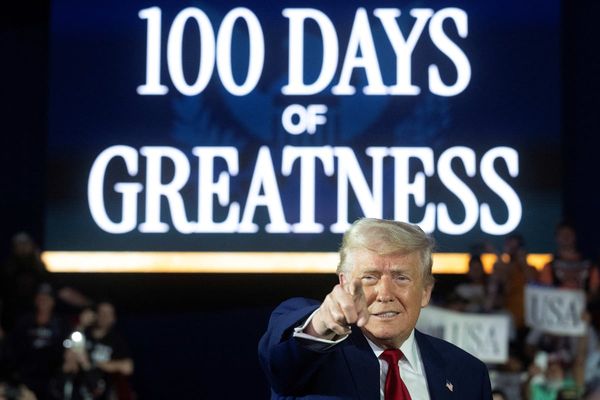
I was wrapping up my visit to Nissan’s headquarters in Yokohama, Japan, waiting in the lobby of the hotel for my ride to the airport. I was feeling cautiously optimistic about Nissan’s turnaround plan after long conversations with the incoming CEO and other executives. The company is bringing hybrids and plug-ins to the U.S., investing in its most successful product and preparing to launch an adventure-focused EV. That all sounded great.
Then I checked the news.
It was March 27 in Yokohama, but still the 26th back in the States. Donald Trump had announced 25% tariffs on all imported cars. Everything I had learned suddenly went out the window.
That new Leaf crossover Nissan had shown off? Slated for arrival this year and, yep, built in Japan. Its upcoming redesigned Sentra? Mexico. I looked at the public relations guy for comment, but he didn’t have anything to say. At a time when Nissan desperately needed a win, the administration had just dealt it another loss.
(Welcome to Power Moves, an InsideEVs column on the winners and losers of the EV race. Every other week, I explore how one of the world’s most vital industries is navigating its biggest shake-up ever. Newsletter subscribers get it delivered directly to their inbox a day before it goes on the site, so if you want early access, sign up below. -- Deputy Editor Mack Hogan)
The Plan
Nissan’s troubles are well-documented, but here’s a quick refresher. Nissan’s leadership for the last 15-odd years chased sales growth over sustainability and market positioning, leaving the company with outdated products and an image that makes you think “rental car.” It pioneered the mass-market EV with the Leaf, then utterly failed to capitalize on that success.

It went from being one of the two players in the EV space to an afterthought there, all while its overall financial performance dwindled. It pursued a merger with Honda, which ultimately failed. Honda, frustrated by its traditional rival’s slow decision-making and weaker position, wanted to make Nissan a subsidiary or junior partner. Nissan’s former CEO scoffed, then got canned, and we all ended up here.

The incoming CEO, Ivan Espinosa, is young, a car enthusiast, a foreigner and full of ideas and energy that the old guard seemed to lack. He noted to me that the company “never stopped” talking to Honda. The two brands are collaborating on certain projects, including EVs. And Espinosa has a “no taboo” approach to partnerships. That’s an important note, as one of the key companies pursuing a partnership with Nissan is Foxconn, the Taiwan-based contract manufacturer that makes your iPhone.
Partnership or not, the key task is cutting costs while also increasing sales of profitable models, a tough ask. Yet many of the plans sounded convincing. Nissan’s best-selling Rogue crossover is finally getting a plug-in hybrid variant this year, with an all-new model arriving in 2026. Last year the Rogue notched 245,724 sales This will also be where Nissan rolls out its excellent e-Power technology, which is a hybrid setup that has no connection between the wheels and the gas engine. It’s basically an extended-range electric vehicle (EREV), but can also be configured as a traditional hybrid without a plug.

Plus, the company showed me upcoming EVs from Nissan and Infiniti, including an Xterra-inspired adventure crossover. A rugged, outdoorsy electric SUV is exactly what consumers want right now, and it’s a sign that Nissan has a finger on the pulse. Plus, the company is working hard to dramatically reduce development time.
That’s an attempt to cure Nissan’s most systemic problem: The company has an awful habit of developing good products, then letting them wither on the vine until they become punch lines. See: the last Frontier, Z, GT-R, Titan and Infiniti Q50.

The company is clearly focused on the right issues. What remains to be seen is if it’s organizationally competent enough to pull this off. Nissan is 20 years past its prime in terms of brand image, and turning around a decadent behemoth is a long shot in the best of times.
But we do not live in the best of times. Certainly not for automakers.
The Problem
A 25% tariff is cataclysmic for an industry where the average transaction price of a new vehicle is already hovering near $50,000. Analysts predict the U.S. car market could shrink by as many as 2 million units this year. Auto companies are lean, future-looking and extraordinarily competitive businesses; if you think you can take 2 million units out of the pie and expect all of them to tough it out, you’re wrong.
Nissan is both less exposed to the tariff issue and, simultaneously, far weaker than its competitors. On the exposure side, its profit drivers are mostly built here, with the exception of the cheap sedans. The company builds the Rogue here, but also imports a substantial number of them from Japan, now subject to a 25% tariff. As our colleagues from Motor1 note, however, it also has far more spare capacity in the U.S. than rivals, giving it more flexibility to onshore production.
The problem is that costs money, and Nissan doesn’t have much. Its $6 billion war chest is peanuts compared to its competitors, and with a loss forecasted this year and awful credit ratings, the company’s access to debt is also more constrained. This will make it hard enough to weather the impact of the tariffs. But if there’s a broad, market-wide recession—an increasingly likely outcome here—I don’t think Nissan will be strong enough to get through it alone.

The Future
I wanted to focus on this because Nissan is the canary in the coal mine. The auto industry is trying to be two things at once. Companies want to be the hot, new, growing businesses that sell flagship software-defined EVs to an enthusiastic public. But they also want to sell proven, traditional ICE cars to a skeptical and unpredictable market.
They need to be disruptive to compete with China’s automakers and new brands like Tesla, Lucid and Rivian, but they need to pay the bills with the stuff that’s profitable now. And they need massive capital investments for things like software and batteries and autonomy.
This tension is squeezing them from both ends. Companies that only make electric software-defined vehicles (SDVs) are struggling with costs and with predicting consumer demand. American, European and Asian automakers are also now up against Chinese EV manufacturers that have solved these issues. Meanwhile, Western brands that focus primarily on the ICE business are making money, but in a market that has been shrinking globally for years.
Nissan is caught between these two worlds, and winning in neither. Its EV plans are exciting, as are its hybrids. But if Nissan can’t get compelling, profitable products to market fast, it’ll end up being swallowed up by a company that can.
Contact the author: Mack.Hogan@insideevs.com.







